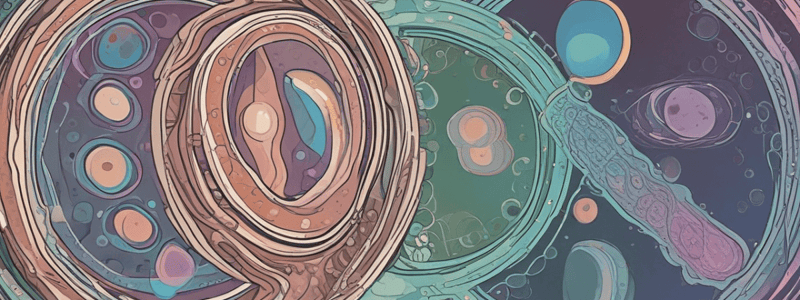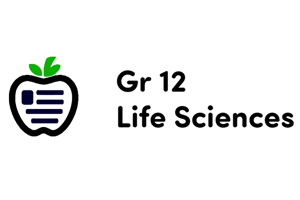Podcast
Questions and Answers
What is the primary function of the mitochondria in the midpiece of a sperm?
What is the primary function of the mitochondria in the midpiece of a sperm?
- To form ATP for the sperm's motility (correct)
- To store genetic information
- To provide energy for locomotion
- To produce enzymes for digestion
What is the main function of the corpora cavernosa in the penis?
What is the main function of the corpora cavernosa in the penis?
- To produce testosterone
- To form the glans penis
- To produce semen
- To fill with blood sinuses during erection (correct)
What is the role of GnRH in the male reproductive system?
What is the role of GnRH in the male reproductive system?
- To regulate the release of sperm
- To stimulate the production of testosterone
- To produce inhibin
- To trigger the release of LH and FSH (correct)
What is the function of androgen-binding protein (ABP) in the male reproductive system?
What is the function of androgen-binding protein (ABP) in the male reproductive system?
What is the primary function of the ovaries in the female reproductive system?
What is the primary function of the ovaries in the female reproductive system?
What is the main function of the uterus in the female reproductive system?
What is the main function of the uterus in the female reproductive system?
What is the function of the 4-inch muscular tube in the female reproductive system?
What is the function of the 4-inch muscular tube in the female reproductive system?
What is the purpose of the clitoris in the female reproductive system?
What is the purpose of the clitoris in the female reproductive system?
What is the only absolute method of birth control?
What is the only absolute method of birth control?
What is the primary function of hormonal birth control methods?
What is the primary function of hormonal birth control methods?
What is the purpose of spermicidal preparations in birth control?
What is the purpose of spermicidal preparations in birth control?
What is fertility awareness?
What is fertility awareness?
What is the main purpose of the reproductive system?
What is the main purpose of the reproductive system?
What is the process that ensures gametes will contain the haploid chromosome number?
What is the process that ensures gametes will contain the haploid chromosome number?
What is the normal and total number of chromosomes in human body cells?
What is the normal and total number of chromosomes in human body cells?
What is the function of the ducts in the reproductive system?
What is the function of the ducts in the reproductive system?
What is the primary function of the ovaries in the female reproductive system?
What is the primary function of the ovaries in the female reproductive system?
How many haploid sperm are formed through meiosis in the male?
How many haploid sperm are formed through meiosis in the male?
What is the scrotum?
What is the scrotum?
What is the name of the mature follicle that contains an oocyte?
What is the name of the mature follicle that contains an oocyte?
What triggers the secretion of LH during the preovulatory phase?
What triggers the secretion of LH during the preovulatory phase?
What is the result of the rupture of a Graafian follicle?
What is the result of the rupture of a Graafian follicle?
What is the order of the stages of follicular development?
What is the order of the stages of follicular development?
What is the term for the white scar left after the corpus luteum?
What is the term for the white scar left after the corpus luteum?
What is the primary function of the fimbriae in the fallopian tube?
What is the primary function of the fimbriae in the fallopian tube?
What is the name of the outer layer of the uterine wall?
What is the name of the outer layer of the uterine wall?
What is the reason for a hysterectomy in the case of endometriosis?
What is the reason for a hysterectomy in the case of endometriosis?
What is the name of the narrow tube that extends from the ovary to the uterus?
What is the name of the narrow tube that extends from the ovary to the uterus?
Which part of the uterus is the site of fetal development?
Which part of the uterus is the site of fetal development?
What is the function of the cilia and peristalsis in the oviduct?
What is the function of the cilia and peristalsis in the oviduct?
Study Notes
Male Reproductive System
- The head of the sperm contains the nucleus and acrosome, which breaks down the egg's surface during fertilization.
- The midpiece contains mitochondria that produce ATP for sperm movement.
- The tail, or flagellum, enables sperm locomotion.
Penis Structure
- The penis is composed of erectile tissue masses filled with blood sinuses.
- The corpora cavernosa is the erectile tissue that contains blood sinuses.
- The corpora spongiosum is the tissue that surrounds the urethra and forms the glans penis.
- The glans penis is the enlarged distal end of the penis.
- The prepuce is the foreskin.
Hormonal Regulation
- Gonadotropin-releasing hormone (GnRH) is released by the hypothalamus, triggering the anterior pituitary gland to release LH and FSH.
- Luteinizing hormone (LH) stimulates Leydig cells to produce testosterone.
- Follicle-stimulating hormone (FSH) stimulates Sertoli cells to secrete androgen-binding protein (ABP), which binds to testosterone.
- Testosterone stimulates spermatogenesis, and as sperm count rises, Sertoli cells produce inhibin, which stops FSH production.
Female Reproductive System
- The primary functions of the female reproductive system are to receive sperm, produce and maintain egg cells, transport eggs to the site of fertilization, provide nutrition and a safe environment for fetal development, and give birth.
- The primary female sex organs are the ovaries, which produce eggs and hormones.
- The accessory sex organs include the uterine tubes, uterus, vagina, labia majora and minora, clitoris, and vestibule.
Vulva Structure
- The vulva is the external female reproductive structure and vaginal opening.
- The mons pubis is the fatty pad over the pubic bone.
- The labia majora is the outer skin fold, and the labia minora is the inner skin fold.
- The clitoris is a small mass of erectile tissue.
Mammary Glands
- Mammary glands are modified sweat glands that produce milk and are located in the breasts.
Birth Control
- The only absolute method of birth control is abstinence.
- Other birth control methods include sterilization, hormonal birth control, intrauterine devices, barrier methods, and spermicidal preparations.
Fertility Awareness
- The reproductive system's main purpose is to produce gametes and unite them to form a new individual.
- Gametes are produced through the process of meiosis, which ensures a haploid chromosome number.
Spermatogenesis
- In the male, meiosis forms four haploid sperm.
- Males produce about 300 million sperm per day from puberty until death.
Oogenesis
- In the female, meiosis forms one haploid egg and up to three haploid polar bodies.
- Females are born with all the eggs they will ever have.
Male Reproductive System Functions
- The three main functions of the male reproductive system are to produce sperm, store sperm, and deliver the sperm to the female reproductive system.
Scrotum
- The scrotum is the sac that contains the testes.
Female Reproductive System Components
- Ovaries produce oocytes and hormones.
- Uterine tubes transport fertilized ova.
- The uterus is the site of fetal development.
- The vagina and external genitalia constitute the vulva.
- Mammary glands produce milk.
Ovarian Hormones
- The ovary produces estrogen and progesterone.
Follicular Development
- The stages of follicular development are primary follicle, secondary follicle, Graafian follicle, and ovulation.
- Corpus luteum is the follicle after ovulation, and Corpus albicans is the white scar left after corpus luteum.
Preovulatory Phase
- The preovulatory phase lasts from day 6 to 13.
- In the ovary, the developing follicle releases estrogen.
- In the uterus, increasing estrogen levels repair and thicken the endometrium.
Ovulation
- High estrogen levels trigger the secretion of LH.
- LH causes the follicle to rupture and release the oocyte.
Postovulatory Phase
- If there is fertilization, the corpus luteum continues to produce progesterone, supporting the pregnancy.
- If there is no fertilization, the corpus luteum degenerates, and the endometrium is shed.
Fallopian Tube
- The fallopian tube is the oviduct that extends from the ovary to the uterus.
- The fimbriae are moving finger-like processes that sweep over the ovary.
Uterus
- The fundus is the dome-shaped top of the uterus.
- The body is the middle portion.
- The cervix is the neck of the uterus that opens into the vagina.
- The uterus is the site of fetal development.
Uterine Wall
- The perimetrium is the outer layer, made of connective tissue.
- The myometrium is the middle layer, made of visceral, smooth muscle.
- The endometrium is the inner layer, made of epithelial tissue.
Hysterectomy
- A hysterectomy is the surgical removal of the uterus.
- Reasons for surgery include endometriosis, ovarian cysts, excessive bleeding, cancer of the cervix, uterus, or ovaries.
Vagina
- The vagina is a muscular, elastic tube that connects the cervix to the outside of the body.
Studying That Suits You
Use AI to generate personalized quizzes and flashcards to suit your learning preferences.
Related Documents
Description
Test your understanding of the reproductive system, including the production of gametes, meiosis, and the formation of a zygote. This quiz covers the basics of human reproduction and the biology behind it.




